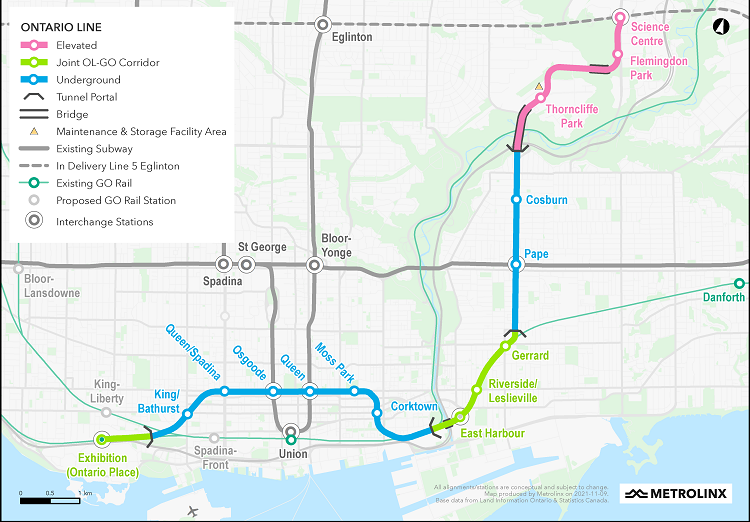What’s up with the Ontario Line?
Breaking down the Ontario Line, Toronto’s next grand rapid-transit expansion.

As anyone who's tried to take the Queen streetcar lately can tell you: construction for the Ontario Line is disrupting the city. If we're going to be diverted for four full years, it's worth asking why. What exactly is the Ontario Line anyway?
Ever since Toronto opened its first subway line along Yonge St. back in 1954, expansion has been the name of the game. Reach more areas, get more people moving.
In relatively short order, the Yonge line became the Yonge-University line, with stops reaching ever farther north. An east-west line opened along Bloor and the Danforth (Line 2). Extensions have come to Scarborough (Line 3) and along Sheppard (Line 4), and a light-rail line is currently being completed along Eglinton (Line 5).
But in all that expansion, a problem emerged. The system’s most popular stations became too popular. Stops at Union and Yonge-Bloor grew overcrowded, which meant they were unsafe for riders and also that trains had to slow down and be extra cautious, cutting into speedy commute times.
The long-proposed and much-discussed Downtown Relief Line (DRL) was meant to change that, particularly eliminating the intense pinch point of Yonge-Bloor Station. It was slated to include eight stations, and run from Pape Station south to Queen St. E., and west to Osgoode Station.
But that’s not happening now. In its place is the Ontario Line. What is the Ontario Line, where will it go, and when will it be ready? Read on for the background and the latest.
Background
First things first: The Ontario Line is a rapid-transit line, though not a full-on subway line like Yonge-University.
It was first pitched by Metrolinx — the agency in charge of transportation in the Greater Toronto and Hamilton Area — as a replacement for the DRL back in early 2019. The new plan was approved by the provincial government in February of that year, and presented to the public that April.
As part of a larger transit deal with the province, Toronto city council approved the Ontario Line plans in October 2019. Capital costs are expected to be $10.9 billion, paid for by the province and with funds from the federal government.
The final line features the same number of stops in the area covered by the DRL (though placement has been altered), but it also extends farther on the northerneastern and southwestern ends.
In all, there will be 15 stops on the 15.6-km line. While much of the line will be underground and use new tunnels, a portion will be at grade or elevated above.
As of October 2019, the province estimated the line would be ready by 2027. However, those timelines have been revised. In December 2020, the timeline for opening was changed to 2030.

Route
The Ontario Line will run from a new stop at Ontario Science Centre in the northeast to Exhibition Place/Ontario Place in the southwest. Along the way it will connect with existing stops at Pape, Queen, and Osgoode.
There will be two other stops along Queen St., at least partially fulfilling an expansion plan long, long in the making.
See our visualization for a look at the complete route, including some info on each stop.
What’s the latest?
A project like this is constantly evolving. Here’s a collection of the stories and reaction, including the most recent news:
- Crews officially broke ground on the Ontario Line on March 27 when they began upgrades on the existing Exhibition Station.
- Ontario Line construction will involve street-level disruptions at major intersections — such as King and Bathurst, where a new stop will be built — as well as some long-term road closures. In a plan approved in December 2021, it was announced that Queen St. will be closed from Bay to Victoria between 2023 and 2027. This will also mean a long-term diversion of the 501 streetcar.
- Back in 2020, the province held four public open houses regarding the Ontario Line, and received push-back on the idea of above-ground stops. In particular, some Thorncliffe Park and Flemingdon Park residents opposed the planned elevated guideway through their neighbourhoods.
Code and markup by Bridget Walsh. ©Torontoverse, 2024